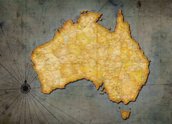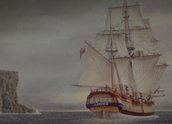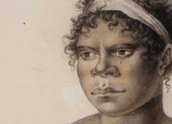


First Australians – Episode 1, They Have Come to Stay (2008)
Synopsis
Episode one covers the first meetings between the Indigenous Aborigines, the first Australians, and the British First Fleet, who sailed into Sydney on 26 January 1788. They soon come face to face and while their differences are immense, apprehension quickly turns to curiosity and friendships form, some between powerful men such as Governor Arthur Phillip and the Aboriginal Bennelong. But by the time this pair leave for London three years later, relations between the two races have soured. The bloodshed worsens as settlers spread out across the land.
Curator’s notes
'They Have Come to Stay’ is an emotional journey. It is touching in its focus on friendships and understanding, sometimes funny in its portrayal of first encounters, and then confronting in its depiction of the violence and prejudice experienced in the first colony of Australia.
The stories of three key Indigenous personalities are explored in this episode: Bennelong, a diplomat-ambassador; Pemulwuy, a freedom fighter; and Windradyne, who is ultimately a peacemaker. All three portraits give us a new perspective on a typically white history.
These stories are told through voice-over narration, interviews and readings of archival accounts layered over modern images of landscape and pictures from the archives. This is incredibly meaningful, given that the sketches, prints and paintings used here to support an Indigenous point of view were actually created by the settlers who would have been inclined to favour the merits of colonisation and despised those who opposed them. These settlers would have ‘documented’ the good works of the Empire for report back to England, and were, essentially, reporting propaganda.
The episode begins with Dreamtime stories from around the country which effectively condenses the prehistory of Australia and its Indigenous people into three minutes. In a talk about the series at the Art Gallery of NSW on 9 February 2009, Rachel Perkins explained how daunting it was to start this project and how it was impossible to tell the story of prehistory as well as colonisation and post-colonial history; something had to be left out. The rest of the series does reference prehistory when discussing the origins of culture and beliefs, but this is the only dedicated synthesis in the series.
This episode also gives the Aboriginal point of view of first contact in an area that had previously been spared from contact with foreigners, at least in comparison to other areas in Western Australia and the Northern Territory, which had a long history of visitations and even trade with travellers such as the Dutch and the Makassans. The extensive use of Aboriginal placenames throughout the episode – and the rest of the series – emphasises the fact that it is Aboriginal land being occupied and indiscriminately apportioned by the invaders. Numerous references to the idealist Indigenous way of life before contact and the religion of Biami remind us of what exactly they have lost.
Being told from an Indigenous perspective does not necessarily mean that the documentary only gives one side of events. Contentious issues such as the outbreak of smallpox are given a fair and balanced discussion so the audience can form their own opinion. However, given the general violence and disregard for human life demonstrated by the British upon arrival in Australia, it is clear why many would believe that the smallpox outbreak was intentional or ‘germ warfare’ as described by Allen Madden.
As well as the adaptability of Aboriginal people there is a recurrent theme of compromise that seems almost inevitable, but which is sometimes a much harder option to take than resistance. Windradyne’s plea for peace, after a series of violent reprisals led by him, was only to save his people. Even though the European and Indigenous people living in the areas featured are still working out how to live together, the episode ultimately ends on a positive note of friendship and is by far the most balanced of the series.
This episode was first broadcast on SBS on Sunday 12 October 2008.
- Overview
- Curator’s notes
- Video 3 clips
- Principal credits
- Find a copy
- Comments 1
- Map
- Reviews 1



